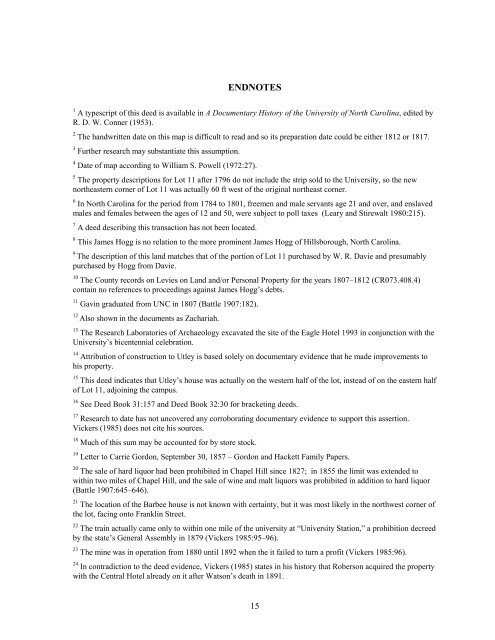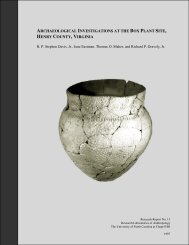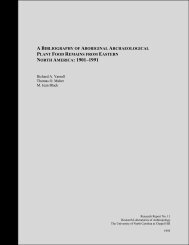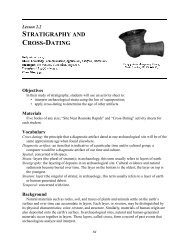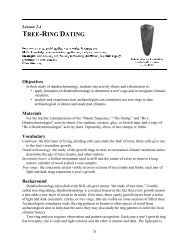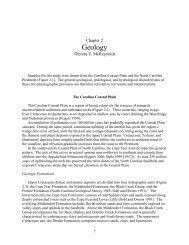In the early morning <strong>of</strong> January 9, 1919, three <strong>of</strong> the fraternity houses (Sigma Nu,Sigma Alpha Epsilon, and Pi Kappa Phi) in the east–west line caught fire and werecompletely destroyed (Wilson 1957:410). The Phi Delta Theta House and the Delta KappaEpsilon (DKE) House (on the western end) were spared the effects <strong>of</strong> the fire. A 1919 aerialview (Figure 15) <strong>of</strong> the campus shows the Phi Delta Theta House as well as the formerlocations <strong>of</strong> the burned fraternities.The library (now Hill Music Hall) almost burned in the fire, and afterwards, because<strong>of</strong> the risk, the University moved immediately to acquire the property where the fraternityhouses had stood (Wilson 1957:410). On January 14, 1919, at a meeting <strong>of</strong> the ExecutiveCommittee <strong>of</strong> the Board <strong>of</strong> Trustees, a motion was made and carried that the Chairman <strong>of</strong> theFaculty and Business Manager be requested to determine whether the University couldacquire the lots where the fraternities had stood. 32 Orange County records show that betweenJanuary and June <strong>of</strong> 1920 the University acquired the lots where the SAE and Sigma Nufraternity houses had stood, and where the former Delta Kappa Epsilon fraternity house stillstands (Deed Book 76:382, 385, 543).The University’s purchase <strong>of</strong> the Phi Delta Theta property was finalized on September10, 1929. The University exchanged a lot at 304 South Columbia Street for the lot uponwhich the fraternity building stood. Nine days later, the University also acquired the lot uponwhich the Pi Kappa Phi house had stood, also in exchange for land on South ColumbiaStreet. According to Robert Paige, Phi Delta Theta fraternity moved to its present location onSouth Columbia Street in October <strong>of</strong> 1929 (Paige, personal communication, June 30, 1997).It is not known when the Phi Delta Theta House was destroyed. The building, listedas a rooming house, is shown still standing on the 1932 Sanborn Map Company map (Figure16). Since it is shown exactly as it had been on the company’s 1915 map, there appear tohave been no additions made subsequently to the building.INTERPRETATIONSIt is likely that the “Poor House,” the large brick-and-stone structure uncovered duringthe archaeological excavations at the Pettigrew site, was built either during Benton Utley’s(1832–1837) or early in Jones Watson’s ownership <strong>of</strong> the Lot 11 property (sometime between1847 and 1853), since deeds and tax records suggest that improvements were being made tothe property during these proprietorships. This was also the period <strong>of</strong> a severe housingshortage for students at the University, making the provision <strong>of</strong> housing a sound investment.It may be that claims for Watson running a boarding house/hotel actually relate to the “PoorHouse” and not to his home, which was the site <strong>of</strong> the later Central Hotel. Further researchmay clarify the matter.The evidence <strong>of</strong> maps, deeds, and photos seems to indicate that the Phi Delta Thetafraternity house was built overlapping the “Poor House” site sometime after Coxe’s purchase<strong>of</strong> the property in 1908, but before 1911 when the house shows up on Sanborn maps and inphotos taken prior to the construction <strong>of</strong> the Battle-Vance-Pettigrew complex in 1912.14
ENDNOTES1 A typescript <strong>of</strong> this deed is available in A Documentary History <strong>of</strong> the University <strong>of</strong> North Carolina, edited byR. D. W. Conner (1953).2 The handwritten date on this map is difficult to read and so its preparation date could be either 1812 or 1817.3 Further research may substantiate this assumption.4 Date <strong>of</strong> map according to William S. Powell (1972:27).5 The property descriptions for Lot 11 after 1796 do not include the strip sold to the University, so the newnortheastern corner <strong>of</strong> Lot 11 was actually 60 ft west <strong>of</strong> the original northeast corner.6 In North Carolina for the period from 1784 to 1801, freemen and male servants age 21 and over, and enslavedmales and females between the ages <strong>of</strong> 12 and 50, were subject to poll taxes (Leary and Stirewalt 1980:215).7 A deed describing this transaction has not been located.8 This James Hogg is no relation to the more prominent James Hogg <strong>of</strong> Hillsborough, North Carolina.9The description <strong>of</strong> this land matches that <strong>of</strong> the portion <strong>of</strong> Lot 11 purchased by W. R. Davie and presumablypurchased by Hogg from Davie.10 The County records on Levies on Land and/or Personal Property for the years 1807–1812 (CR073.408.4)contain no references to proceedings against James Hogg’s debts.11 Gavin graduated from UNC in 1807 (Battle 1907:182).12Also shown in the documents as Zachariah.13 The <strong>Research</strong> <strong>Laboratories</strong> <strong>of</strong> Archaeology excavated the site <strong>of</strong> the Eagle Hotel 1993 in conjunction with theUniversity’s bicentennial celebration.14 Attribution <strong>of</strong> construction to Utley is based solely on documentary evidence that he made improvements tohis property.15 This deed indicates that Utley’s house was actually on the western half <strong>of</strong> the lot, instead <strong>of</strong> on the eastern half<strong>of</strong> Lot 11, adjoining the campus.16 See Deed Book 31:157 and Deed Book 32:30 for bracketing deeds.17 <strong>Research</strong> to date has not uncovered any corroborating documentary evidence to support this assertion.Vickers (1985) does not cite his sources.18 Much <strong>of</strong> this sum may be accounted for by store stock.19 Letter to Carrie Gordon, September 30, 1857 – Gordon and Hackett Family Papers.20 The sale <strong>of</strong> hard liquor had been prohibited in Chapel Hill since 1827; in 1855 the limit was extended towithin two miles <strong>of</strong> Chapel Hill, and the sale <strong>of</strong> wine and malt liquors was prohibited in addition to hard liquor(Battle 1907:645–646).21 The location <strong>of</strong> the Barbee house is not known with certainty, but it was most likely in the northwest corner <strong>of</strong>the lot, facing onto Franklin Street.22 The train actually came only to within one mile <strong>of</strong> the university at “University Station,” a prohibition decreedby the state’s General Assembly in 1879 (Vickers 1985:95–96).23 The mine was in operation from 1880 until 1892 when the it failed to turn a pr<strong>of</strong>it (Vickers 1985:96).24 In contradiction to the deed evidence, Vickers (1985) states in his history that Roberson acquired the propertywith the Central Hotel already on it after Watson’s death in 1891.15
- Page 1 and 2: ARCHAEOLOGICAL INVESTIGATIONS AT TH
- Page 3 and 4: ABSTRACTArchaeological investigatio
- Page 5 and 6: Moffitt, Brooks Rainey, Patricia Sa
- Page 7 and 8: ChapterPage6. Conclusions and Recom
- Page 9 and 10: TablePage16. Distribution of cerami
- Page 11 and 12: FigurePage18. Excavating Sq. 140R95
- Page 13 and 14: Chapter 1INTRODUCTIONThis report de
- Page 15 and 16: Chapter 2HISTORICAL BACKGROUNDThe t
- Page 17 and 18: Book 17:59-60). Gavin Hogg paid off
- Page 19 and 20: and the sale of the western half of
- Page 21 and 22: After the Civil War, the town fell
- Page 23 and 24: train young men and women to teach
- Page 25: the university was the Delta Kappa
- Page 29 and 30: Chapter 3FIELD METHODSFieldwork was
- Page 31 and 32: Chapter 4RESULTS OF ARCHAEOLOGICAL
- Page 33 and 34: foundations were 2 ft wide and the
- Page 35 and 36: Level 2aThis soil level occurred on
- Page 37 and 38: Feature 2Feature 2 was a linear dis
- Page 39 and 40: Feature 12Feature 12 was a small, s
- Page 41 and 42: ARCHITECTURAL GROUPA large number o
- Page 43 and 44: southern and northern parts of the
- Page 45 and 46: Kitchen GroupCeramics. As shown in
- Page 47 and 48: is probably no earlier than the sec
- Page 49: consumption of wine in ante-bellum
- Page 53 and 54: 50% of the assemblage). If, and whe
- Page 55 and 56: sat down. Diners then helped themse
- Page 57 and 58: ecords show his property increased
- Page 59 and 60: The ceramic marbles could easily be
- Page 61 and 62: southern to northern halves of the
- Page 63 and 64: anthropomorphic pipes (Sudbury 1979
- Page 65 and 66: TOILETRIES GROUPThe Toiletries grou
- Page 67 and 68: shampoo bottles, and a cosmetic jar
- Page 69 and 70: Items likely associated with the fr
- Page 71 and 72: Chapter 6CONCLUSIONS AND RECOMMENDA
- Page 73 and 74: REFERENCESAnonymousc.1797 Plan of t
- Page 75 and 76: Majewski, Teresita, and Michael J.
- Page 77 and 78:
Wilson, Louis R.1957 The University
- Page 79 and 80:
Table 1 continued.Activity Group Qu
- Page 81 and 82:
Table 3 continued.Category 0-2 cm 2
- Page 83 and 84:
Table 7. Distribution of kitchen ce
- Page 85 and 86:
Table 10. Distribution of ceramic t
- Page 87 and 88:
Table 13. Distribution of glass and
- Page 89 and 90:
Table 17. Distribution of pharmaceu
- Page 91 and 92:
PRESBYTERIANCHURCHHENDERSON STREETN
- Page 93 and 94:
Figure 4. 1797 map of Chapel Hill a
- Page 95 and 96:
Figure 6. 1857 Chapel Hill Business
- Page 97 and 98:
Figure 8. View of Franklin Street l
- Page 99 and 100:
Figure 10. Portion of a 1911 map co
- Page 101 and 102:
Figure 12. Delta Kappa Epsilon hous
- Page 103 and 104:
Figure 14. Kemp P. Battle with Phi
- Page 105 and 106:
Figure 16. Portion of a 1932 map co
- Page 107 and 108:
Figure 18. Excavating Sq. 140R95 pr
- Page 109 and 110:
Figure 20. Removing topsoil from th
- Page 111 and 112:
Figure 22. Exposing the south wall
- Page 113 and 114:
Pettigrew Site(RLA-Or412)Architectu
- Page 115 and 116:
Stone FoundationsStone FoundationsD
- Page 117 and 118:
Figure 28. View of Structure 2 full
- Page 119 and 120:
160 150 140 130 120 110 100100 ft99
- Page 121 and 122:
Figure 32. Prehistoric lithic artif
- Page 123 and 124:
Figure 34. Miscellaneous ceramic an
- Page 125 and 126:
Figure 36. Glassware: oil lamp chim
- Page 127 and 128:
Figure 38. Stoneware: Virginia-made
- Page 129 and 130:
Figure 40. Refined, undecorated war
- Page 131 and 132:
Figure 42. Whiteware plate, 9.5”
- Page 133 and 134:
Figure 44. Transfer printed wares:
- Page 135 and 136:
Figure 46. Transfer printed wares:
- Page 137 and 138:
Figure 48. Toothbrushes and possibl
- Page 139 and 140:
Figure 50. Early to mid-nineteenth-
- Page 141 and 142:
Figure 52. Refined, undecorated whi
- Page 143 and 144:
Figure 54. Glass cosmetic and shamp
- Page 145 and 146:
Appendix 1. Chain of title for Lot
- Page 147 and 148:
30030024060300Lot 11George Johnston


